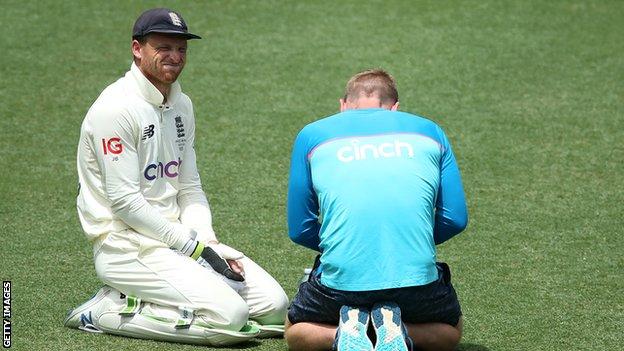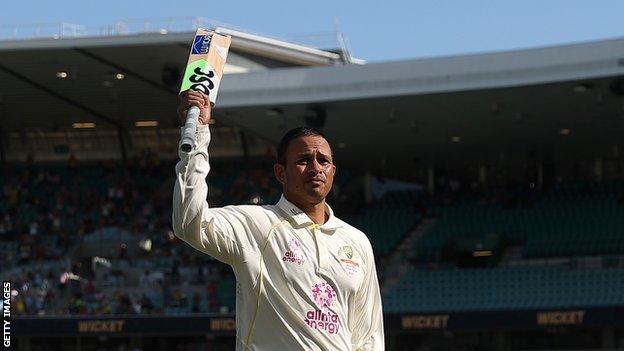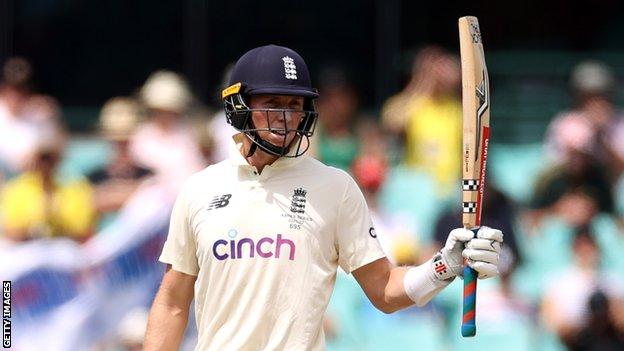ARTICLE AD BOX
 England batted throughout the fifth day of the Sydney Test to secure a draw
England batted throughout the fifth day of the Sydney Test to secure a drawThe dramatic Sydney draw, England's second non-defeat in their past 14 Tests in Australia, has enlivened an Ashes series which had been charting a course of familiar, repetitive one-sidedness.
Even if the final result was facilitated by around 60 overs being lost from the game and some flawed Australian fielding, Stuart Broad and Jonny Bairstow finally provided individual landmarks to enjoy, Zak Crawley offered hope for a less collapsible future top-order, and cricket enjoyed a fantastically gripping denouement.
It was the ninth time England have secured a draw in a Test with the final pair at the wicket, seven of which have been in the past 24 years.
In addition, four of the five games in which England have been denied by a last-wicket pair have occurred since 2005 - truly, this has been a golden age for nail-biting draws involving England, which have come at a rate of almost one every two years, having previously trickled into existence at one per 40 years.
Here are my five statistical nuggets from the SCG.
Bairstow breaks new ground
 Bairstow's hundred was his first in Tests since November 2018
Bairstow's hundred was his first in Tests since November 2018No visiting batsman at number six or lower in the order has made a Test century in Australia having walked to the wicket with fewer runs on the board than the 36-4 England had scored before Jonny Bairstow began his innings.
Bairstow made one of the finest centuries by an England player in Australia in recent times (admittedly, not an over-crowded field).
It was the 52nd hundred by a visiting Test player in Australia batting at number six or lower.
Only two had started with the score below 75 - Faf du Plessis' debut 110 not out, from 45-4, in another fourth-innings rearguard, for South Africa at Adelaide in November 2012, and Tony Greig's 110 in Brisbane in the 1974-75 Ashes, which began with England 57-4 after their first encounter with the Lillee-Thomson pace attack.
Bairstow's hundred was, almost certainly, the finest made by a player who had not passed 60 in his previous 37 Test innings, one of the longest such sequences ever by a non-tailender.
Time will tell whether the SCG Test, the first in which he has batted more than 100 balls in both innings, proves to be the start of a new phase in Bairstow's fluctuating career.
Ch-ch-changes
 Buttler broke a finger while wicketkeeping during Australia's first innings in Sydney
Buttler broke a finger while wicketkeeping during Australia's first innings in SydneyJos Buttler has returned home after a disappointing series for both wicketkeepers - he and Australia's Alex Carey between them average 15.5 with the bat, the lowest such figure in an Ashes series since 1962-63, and both have missed several good chances with the gloves.
His departure means England will end the series with a maximum of four ever-present players, possibly as few as two if Haseeb Hameed is dropped and Ben Stokes unfit to play.
They have never completed a five-Test Ashes in Australia with fewer than four players having appeared in every match, so this England team will at least tie the record, set in 2002-03 (when Michael Vaughan, Marcus Trescothick, Mark Butcher and captain Nasser Hussain were the only players to play all five Tests) and 1958-59 (Peter May, Tom Graveney, Colin Cowdrey and Trevor Bailey).
Unsurprisingly, both of those tours were also thumping Australian victories.
In 1974-75, another difficult Ashes winter for England, only two players - Tony Greig and Alan Knott - played all six Tests, and only they and Bob Willis played in the first five.
It is fair to say that, among the various tools England have tried to halt Australian Ashes momentum, selectorial mayhem has been the least effective.
An unforgettable Test for fans of number fives reaching 50
 Khawaja scored two hundreds in his first Test since August 2019
Khawaja scored two hundreds in his first Test since August 2019The fourth Test was also, in a not especially meaningful but statistician-exciting quirk, only the second Test ever played in which the number five batter reached 50 in all four innings.
Usman Khawaja's two silken centuries and Stokes' pair of pain-stricken sixties matched the combined efforts of the four different number fives (Dudley Nourse and Ken Viljoen for South Africa, Les Ames and Eddie Paynter for England) in the famous Durban Test of 1938-39.
That was a timeless match which lasted from 3-14 March, and ended in a draw with England 654-5 chasing 696 to win before catching the ship home took precedence over winning a Test match.
South Africa seamer Norman Gordon bowled 728 balls in the game before finally taking a wicket, only 77 balls fewer than the fatiguing Mitchell Starc has bowled in the entire series so far this winter, and more than 100 balls more than Jimmy Anderson in his three Tests.
Despite what was a tiring, average-damaging couple of weeks for Gordon, he did apparently come close to discovering that bowling 700 wicketless balls in a Test may hold the secret to eternal life - he lived to 103, an age unmatched by any other male Test cricketer.
Low returns for England bowlers
 Australia bowlers hold the top five places in the series leading wicket-takers list
Australia bowlers hold the top five places in the series leading wicket-takers listIt has been a curious series for England's bowlers, who collectively average 39.4, giving them the best (or least bad) team bowling average of the five third-millennium Ashes thrashings that England have endured.
James Anderson has conceded 1.79 runs per over, currently the most economical series by a seam bowler in Australia (100 overs minimum) since 1978-79, the sixth most parsimonious since 1900, and the most frugal by any bowler in Australia since Shane Warne stiflingly demolished Pakistan in 1995-96.
However, he has taken only eight wickets in his three Tests, as Australia, as they did four years ago, have blunted him with stonewalling respect.
Mark Wood has bowled with heroically persistent speed but without luck or penetration, Broad was superb in the first innings at Sydney, in which he became the third oldest seamer to take a five-wicket haul in Australia in the past 70 years (after Glenn McGrath and Richard Hadlee), but other than that has two wickets in 47 overs.
Jack Leach has improved, and took England's first spin four-for since 2010-11 thanks to Pat Cummins' belated declaration, but has been comfortably milked for 3.6 runs per over since his Brisbane hammering.
England's leading wicket-taker is Ollie Robinson, who has tested but not damaged Australia, with nine, as many as Australia's fifth most wicketous bowler, Cameron Green, whose dismissal of Zak Crawley with a perfect yorker was the sixth time in the series he has removed a well-set top-order batsman on 25 or more.
There had only been one previous Ashes series in which England had reached the end of the fourth Test without at least one bowler posting double figures in the wickets column - 1926, when the first four Tests were three-day matches, all of which were draws, and in one of which England did not have a chance to bowl because of rain.
Crawley does the heavy lifting
 Crawley's 77 was his second highest score in Tests
Crawley's 77 was his second highest score in TestsOnly once has an England player scored more of the team's first 100 runs in an innings than Zak Crawley's 77 in the second innings of the Sydney Test.
If Bairstow's hundred was a startling performance for someone without a score of 60 in over two years, Crawley's majestic knock was in staggering contrast to his struggles of 2021, when statistically he had one of the worst calendar years any specialist batter has endured in Tests.
In matches where such information has been recorded (most but not all of England's Tests), only Graham Gooch has scored more when England reached 100, and his 82 in Chennai in 1981-82 (en route to 127) was aided by having Chris Tavare at the other end grinding his way to a five-and-a-half-hour 35.

- Smash your 2022 goals: Huge dance tunes and motivational messages for a new year workout
- 5 Minutes On: A new education programme to teach the devastating impacts of compulsive gambling


 3 years ago
37
3 years ago
37








 English (US) ·
English (US) ·